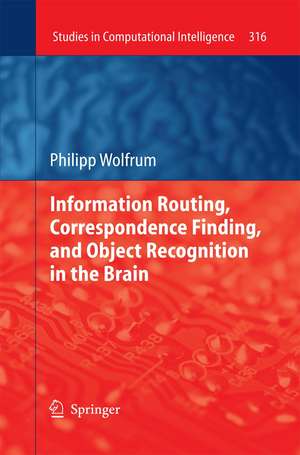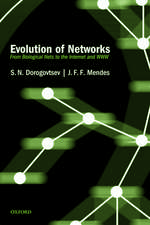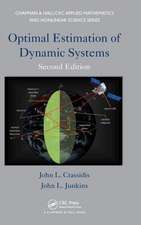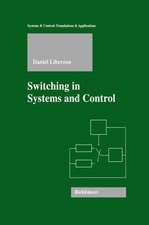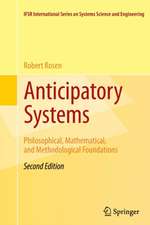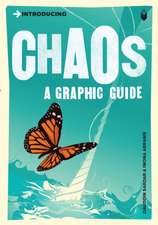Information Routing, Correspondence Finding, and Object Recognition in the Brain: Studies in Computational Intelligence, cartea 316
Autor Philipp Wolfrumen Limba Engleză Paperback – 13 noi 2014
| Toate formatele și edițiile | Preț | Express |
|---|---|---|
| Paperback (1) | 627.93 lei 6-8 săpt. | |
| Springer Berlin, Heidelberg – 13 noi 2014 | 627.93 lei 6-8 săpt. | |
| Hardback (1) | 638.57 lei 6-8 săpt. | |
| Springer Berlin, Heidelberg – 8 sep 2010 | 638.57 lei 6-8 săpt. |
Din seria Studies in Computational Intelligence
- 20%
 Preț: 449.37 lei
Preț: 449.37 lei - 20%
 Preț: 1158.26 lei
Preț: 1158.26 lei - 20%
 Preț: 986.66 lei
Preț: 986.66 lei - 20%
 Preț: 1452.76 lei
Preț: 1452.76 lei - 20%
 Preț: 168.78 lei
Preț: 168.78 lei - 20%
 Preț: 1291.10 lei
Preț: 1291.10 lei - 18%
 Preț: 1112.30 lei
Preț: 1112.30 lei - 20%
 Preț: 565.39 lei
Preț: 565.39 lei - 20%
 Preț: 649.28 lei
Preț: 649.28 lei - 20%
 Preț: 1047.73 lei
Preț: 1047.73 lei - 20%
 Preț: 1578.96 lei
Preț: 1578.96 lei - 20%
 Preț: 643.50 lei
Preț: 643.50 lei - 20%
 Preț: 657.49 lei
Preț: 657.49 lei - 20%
 Preț: 993.28 lei
Preț: 993.28 lei - 20%
 Preț: 990.80 lei
Preț: 990.80 lei - 20%
 Preț: 989.96 lei
Preț: 989.96 lei - 20%
 Preț: 1165.69 lei
Preț: 1165.69 lei - 20%
 Preț: 1444.52 lei
Preț: 1444.52 lei - 20%
 Preț: 1041.96 lei
Preț: 1041.96 lei - 20%
 Preț: 1047.73 lei
Preț: 1047.73 lei - 20%
 Preț: 1046.06 lei
Preț: 1046.06 lei - 18%
 Preț: 2500.50 lei
Preț: 2500.50 lei - 20%
 Preț: 989.13 lei
Preț: 989.13 lei - 20%
 Preț: 1165.69 lei
Preț: 1165.69 lei - 20%
 Preț: 1164.05 lei
Preț: 1164.05 lei - 20%
 Preț: 1042.79 lei
Preț: 1042.79 lei - 20%
 Preț: 1460.19 lei
Preț: 1460.19 lei - 18%
 Preț: 1403.52 lei
Preț: 1403.52 lei - 18%
 Preț: 1124.92 lei
Preț: 1124.92 lei - 20%
 Preț: 1039.47 lei
Preț: 1039.47 lei - 20%
 Preț: 1008.11 lei
Preț: 1008.11 lei - 20%
 Preț: 1045.25 lei
Preț: 1045.25 lei - 20%
 Preț: 1275.42 lei
Preț: 1275.42 lei - 20%
 Preț: 1040.32 lei
Preț: 1040.32 lei - 20%
 Preț: 988.32 lei
Preț: 988.32 lei - 20%
 Preț: 1169.79 lei
Preț: 1169.79 lei - 20%
 Preț: 1162.37 lei
Preț: 1162.37 lei - 20%
 Preț: 1059.26 lei
Preț: 1059.26 lei - 20%
 Preț: 1164.05 lei
Preț: 1164.05 lei - 20%
 Preț: 1166.52 lei
Preț: 1166.52 lei - 20%
 Preț: 1459.38 lei
Preț: 1459.38 lei - 18%
 Preț: 1005.74 lei
Preț: 1005.74 lei - 20%
 Preț: 997.38 lei
Preț: 997.38 lei - 20%
 Preț: 1055.94 lei
Preț: 1055.94 lei - 20%
 Preț: 1284.47 lei
Preț: 1284.47 lei - 20%
 Preț: 994.08 lei
Preț: 994.08 lei - 20%
 Preț: 1048.72 lei
Preț: 1048.72 lei - 20%
 Preț: 1066.02 lei
Preț: 1066.02 lei - 20%
 Preț: 943.78 lei
Preț: 943.78 lei - 20%
 Preț: 1173.10 lei
Preț: 1173.10 lei
Preț: 627.93 lei
Preț vechi: 738.75 lei
-15% Nou
Puncte Express: 942
Preț estimativ în valută:
120.17€ • 124.100$ • 99.21£
120.17€ • 124.100$ • 99.21£
Carte tipărită la comandă
Livrare economică 14-28 aprilie
Preluare comenzi: 021 569.72.76
Specificații
ISBN-13: 9783642423109
ISBN-10: 3642423108
Pagini: 156
Ilustrații: XV, 133 p.
Dimensiuni: 155 x 235 x 8 mm
Greutate: 0.23 kg
Ediția:2010
Editura: Springer Berlin, Heidelberg
Colecția Springer
Seria Studies in Computational Intelligence
Locul publicării:Berlin, Heidelberg, Germany
ISBN-10: 3642423108
Pagini: 156
Ilustrații: XV, 133 p.
Dimensiuni: 155 x 235 x 8 mm
Greutate: 0.23 kg
Ediția:2010
Editura: Springer Berlin, Heidelberg
Colecția Springer
Seria Studies in Computational Intelligence
Locul publicării:Berlin, Heidelberg, Germany
Public țintă
ResearchCuprins
Background and Concepts.- A Correspondence-Based Neural Model for Face Recognition.- Switchyards-Routing Structures in the Brain.- Ontogenesis of Switchyards.- Putting the Pieces Together: Recognition with Switchyards.- Discussion and Outlook.
Textul de pe ultima copertă
This book covers recent research on cortical signal processing and plasticity, with an emphasis on object recognition. Differently from other texts which study the behavior of single neurons, however, the focus here is on assemblies of neurons and how they can collectively represent information patterns and their dynamic relationships. This viewpoint leads to novel concepts for how the brain routes information in a purposeful way, how it detects correspondences between patterns, and how sensory inputs are recognized. To illustrate the function of these concepts, the author proceeds to develop several concrete neural models, including a powerful system for face recognition. Other parts of the book treat the question which neural substrates are necessary for such capabilities, and how they can self-organize in the developing organism.While most of the explicit examples in the book are drawn from vision, the concepts described apply to all areas of neural function from sensory perception to motor control to abstract reasoning. Consequently, readership is aimed at all students and researchers in neuroscience interested in exploring new paradigms of brain function.Experimentalists may draw inspiration from the book for designing anatomical and physiological experiments that lead the way from the current focus on static receptive fields to investigating the dynamic, functional connectivity of cortex. Theoreticians are invited to incorporate the discussed concepts into their own modeling, and to improve on the models presented in the book. While familiarity with the basic notions of theoretical neuroscience is useful for enjoying this book, it also offers to those without a vision background an introduction to the function of the mammalian visual pathway, as well as a broad discussion of different computer vision approaches to object recognition.
Caracteristici
Provides understanding of the (Self)Organization of Cortical Networks Recent research on Information Routing, Correspondence Finding, and Object Recognition in the Brain Written by an expert in the field
